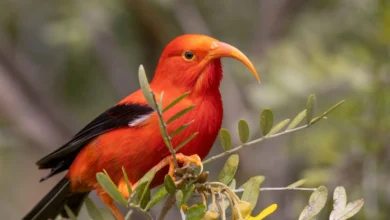The African Forest Elephant (Loxodonta cyclotis): A Comprehensive Guide to Their Origin, Status, and Conservation
Introduction
The African forest elephant (Loxodonta cyclotis) is one of the most enigmatic and endangered megafauna species on Earth. Smaller than their savanna counterparts, these elusive giants play a crucial role in maintaining the biodiversity of Central and West Africa’s rainforests. Despite their ecological importance, they face severe threats from poaching, habitat loss, and human-wildlife conflict. This article explores their evolutionary origins, current population status, distribution, and the most effective strategies to ensure their survival.
1. Origin and Evolution of the African Forest Elephant
1.1 Taxonomic Distinction
For many years, African elephants were considered a single species (Loxodonta africana). However, genetic and morphological studies have confirmed that Africa is home to two distinct species:
-
African savanna elephant (Loxodonta africana)
-
African forest elephant (Loxodonta cyclotis)
The forest elephant is smaller, with straighter tusks, rounded ears, and a more compact body adapted for dense forest habitats. Genetic evidence suggests they diverged from savanna elephants around 2–7 million years ago.
1.2 Evolutionary Adaptations
African forest elephants have evolved several unique traits:
-
Smaller size (2.5 meters tall vs. savanna elephants’ 3.5 meters) for navigating dense vegetation.
-
Straight, downward-pointing tusks to avoid entanglement in forest undergrowth.
-
Highly specialized diet, feeding on fruits, leaves, and bark, making them key seed dispersers.
2. Current Population and Distribution
2.1 Population Decline
The African forest elephant has experienced catastrophic declines due to poaching and habitat destruction:
-
Historic range: Once widespread across West and Central Africa’s rainforests.
-
Current estimates: Fewer than 100,000 individuals remain (IUCN, 2021), a decline of over 86% in the last 30 years.
-
Strongholds: Largest populations survive in Gabon, the Republic of Congo, and Cameroon.
2.2 Geographic Range
Forest elephants are now restricted to fragmented habitats in:
-
Central Africa: Gabon (~60% of remaining population), Republic of Congo, Central African Republic, Democratic Republic of Congo (DRC).
-
West Africa: Smaller populations in Liberia, Côte d’Ivoire, Ghana, and Nigeria.
2.3 Threats to Survival
A. Poaching for Ivory
-
Despite the 1989 ivory ban, illegal poaching persists due to high demand in Asia.
-
Forest elephant ivory is denser and more prized than savanna elephant tusks.
B. Habitat Loss
-
Logging, agriculture, and infrastructure development fragment forests.
-
By 2050, up to 60% of their habitat could be lost without intervention.
C. Human-Wildlife Conflict
-
Crop raiding leads to retaliatory killings by farmers.
-
Expanding human settlements further reduce available habitat.
D. Climate Change
-
Alters forest ecosystems, affecting food availability.
-
Increased droughts and fires threaten their survival.
3. Ecological Importance of Forest Elephants
3.1 Keystone Species
Forest elephants are “ecosystem engineers”:
-
Seed Dispersal: They consume over 100 fruit species, dispersing seeds over long distances.
-
Forest Regeneration: Their feeding habits promote tree diversity and carbon sequestration.
-
Trail Creation: Their movement patterns create pathways used by other wildlife.
3.2 Carbon Storage Impact
Studies show that forests with elephants store 5–10% more carbon due to their role in promoting large, slow-growing trees.
4. Conservation Strategies to Save African Forest Elephants
4.1 Anti-Poaching and Law Enforcement
-
Increased ranger patrols (e.g., Gabon’s use of drones and sniffer dogs).
-
Stricter penalties for wildlife trafficking.
-
International cooperation (e.g., INTERPOL’s Wildlife Crime Unit).
4.2 Habitat Protection and Corridors
-
Expanding protected areas (e.g., Congo Basin’s TRIDOM landscape).
-
Creating wildlife corridors to connect fragmented populations.
-
Community-based conservation to reduce human-elephant conflict.
4.3 Reducing Ivory Demand
-
Public awareness campaigns in consumer countries (China, Vietnam, Thailand).
-
Alternative livelihoods for communities dependent on poaching.
4.4 Scientific Research and Monitoring
-
GPS collaring to track elephant movements.
-
Genetic studies to assess population health.
-
Camera traps for population estimates.
4.5 Community Involvement
-
Compensation schemes for farmers affected by crop raiding.
-
Eco-tourism initiatives to provide economic incentives for conservation.
5. Success Stories and Ongoing Efforts
5.1 Gabon’s Leadership in Conservation
-
Gabon houses 60–70% of remaining forest elephants.
-
Established 13 national parks and implemented strict anti-poaching laws.
5.2 The Elephant Protection Initiative (EPI)
-
A coalition of African nations working to close ivory markets and strengthen protections.
5.3 NGO Efforts
-
World Wildlife Fund (WWF): Supports anti-poaching and habitat restoration.
-
Wildlife Conservation Society (WCS): Conducts critical research in Central Africa.
6. The Future of African Forest Elephants
Without urgent action, forest elephants could face extinction within decades. Key steps for their survival include:
-
Global funding for anti-poaching and habitat protection.
-
Stronger international laws against ivory trade.
-
Sustainable development policies in elephant range states.
-
Increased research to understand their ecological needs.
Conclusion
The African forest elephant is not just a symbol of Africa’s wilderness—it is a vital component of healthy rainforest ecosystems. Saving this species requires a combination of strict law enforcement, habitat conservation, and global cooperation. By acting now, we can ensure that these magnificent giants continue to roam the forests for generations to come.
References
-
IUCN Red List (2021). Loxodonta cyclotis.
-
WWF, WCS, and Elephant Protection Initiative reports.
-
Scientific studies on elephant ecology and conservation.




